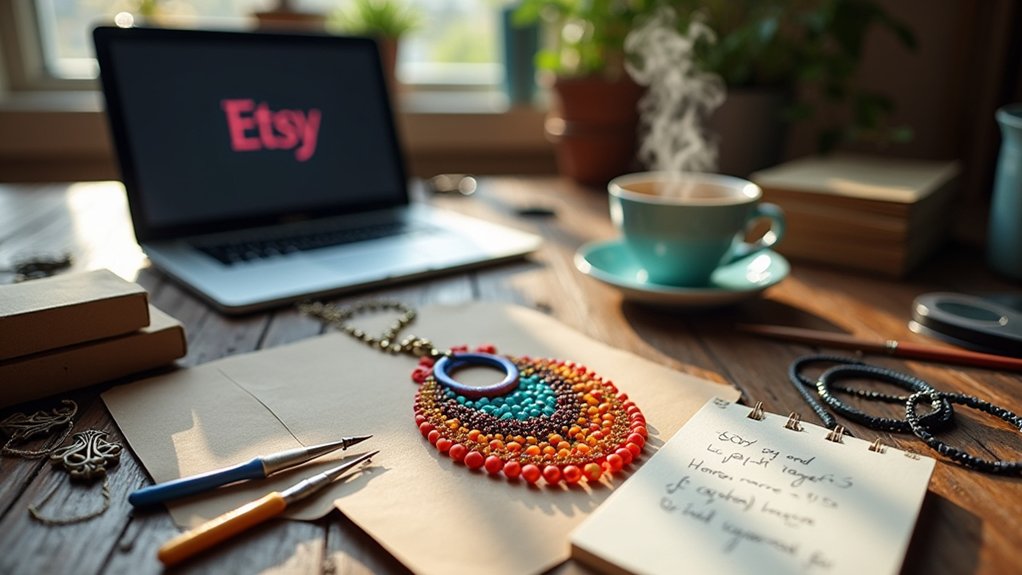Etsy allows the sale of AI-generated art, but sellers must navigate complex copyright and ethical considerations. Works need to be original, with transparency in their AI-generated nature essential to avoid misrepresentation. There’s a need to comply with Etsy’s evolving terms, emphasizing originality and quality. Ethical practices must be observed to respect traditional artistry. Remaining informed and exploring extensive strategies and guidelines will be beneficial for successful sales.
Key Takeaways
- Etsy allows the sale of AI-generated art, but sellers must comply with its terms of service regarding originality and quality.
- AI-generated art on Etsy should transparently indicate its creation process to maintain buyer trust and avoid misrepresentation.
- Current U.S. Copyright Office policies do not recognize AI-generated content as having human authorship, complicating copyright claims.
- Sellers must ensure their AI art does not infringe on existing copyrights to avoid legal issues.
- Ethical practices are crucial to respect traditional artists and maintain a fair marketplace for both AI and handmade art.
Exploring the AI Art Phenomenon
The emergence of AI-generated art represents a significant transformation in the creative field, driven by advancements in machine learning algorithms. This innovation has fostered a burgeoning market on platforms like Etsy, where digital products crafted by AI captivate buyers.
Artists employ tools like Midjourney and DALL-E to create unique visuals, yet the artistic community debates the implications. Ethical considerations and copyright questions arise, as traditional artists fear the devaluation of human craftsmanship.
As AI art gains traction, clear guidelines on ownership are essential. Additionally, the democratization of creativity, facilitated by accessible AI tools, allows individuals without formal training to contribute to the digital marketplace, reshaping online art sales and challenging established norms within the artistic community.
The Intersection of AI and Creativity
As AI-generated art continues to permeate platforms like Etsy, an intriguing intersection emerges between artificial intelligence and human creativity. This collaboration challenges traditional notions of authorship and creativity by utilizing machine learning algorithms to analyze vast datasets, producing unique visuals.
The fusion of AI and creativity allows artists to transcend conventional boundaries, exploring new styles and concepts. However, this innovation raises ethical considerations about originality, ownership, and the devaluation of human artistic labor.
Transparency in the creation process is paramount, ensuring that AI’s role is clearly communicated to foster trust and mitigate concerns of deception. As AI art’s prevalence grows, ongoing discussions about its implications on artistic integrity, copyright laws, and the future of artistic professions become increasingly significant.
Etsy: A Platform for Artistic Expression
Etsy, as a vibrant marketplace, offers a unique platform for artistic expression, celebrating both handmade and AI-generated artworks. It supports a diverse artistic community by allowing artists to sell digital products, including AI-generated art, alongside traditional pieces.
The platform’s ethos emphasizes originality and quality, encouraging sellers to present unique creations that merge innovation with established art forms. With Etsy‘s global reach, artists can connect with a broader audience, highlighting the potential of AI-generated art.
However, this integration requires careful navigation of copyright issues and ethical considerations, ensuring that AI artworks adhere to the principles of original work. As Etsy remains open to digital innovation, artists must remain vigilant about potential shifts in platform policies affecting AI-generated creations.
When delving into Etsy’s terms of service, sellers of AI-generated art must meticulously guarantee compliance with the platform’s unique blend of regulations for handmade and seller-designed items.
Etsy’s policy allows the sale of digital products, including AI-generated art, provided that sellers actively participate in the creation process. To avoid copyright infringement, sellers must make certain their art does not utilize copyrighted characters or brands without permission.
Transparency remains essential; product descriptions should clearly state the AI-generated nature of the art to prevent misleading customers.
Sellers should also verify the terms of service of the AI platform used to confirm compliance with commercial use guidelines. As Etsy’s policies may evolve, staying informed about updates is critical to avoid potential legal implications.
Legal Implications of Selling AI Art
Understanding the intricate legal terrain surrounding AI-generated art on platforms like Etsy is a fundamental aspect for sellers wishing to engage in this market.
The U.S. Copyright Office‘s stance that AI-generated content lacks “human authorship” presents significant legal implications, particularly concerning copyright infringement. Sellers must guarantee their creations do not violate existing copyrights, especially when involving recognizable characters or brands.
Etsy’s lack of clear policies on AI art necessitates heightened transparency, with sellers being upfront about the AI origin to mitigate potential legal issues.
In addition, examining the terms of service of AI platforms is critical, as these may impose restrictions on commercial use.
Ethical considerations also demand transparency to maintain trust and respect for traditional artistry.
Copyright Challenges in AI-Generated Creations
Given the escalating interest in AI-generated art, steering through copyright challenges has become increasingly imperative for creators utilizing such technology.
The 2022 ruling by the U.S. Copyright Office underscores the complexity of the legal framework, as AI-generated art is deemed ineligible for copyright protection due to the absence of human authorship. This presents challenges in ownership, particularly when the creative process involves algorithms and data that may infringe on existing copyrights.
Sellers must navigate potential infringement by ensuring originality in their prompts and avoiding copyrighted elements without permission. Furthermore, transparency in disclosing AI involvement is critical, as it addresses ethical considerations and mitigates risks of misrepresentation.
Maintaining ethical practices and compliance with legal standards is essential to uphold artistic integrity.
Ethical Considerations in AI Art Sales
How do ethical considerations shape the terrain of AI art sales? Ethical implications center around the artistic value of AI-generated works versus traditional art.
Transparency is crucial; sellers must disclose the AI’s contribution to maintain honesty in art’s origin. Concerns about increased competition arise, as AI art potentially floods the market, threatening traditional artists‘ livelihoods and devaluing their skill and craftsmanship.
Fair compensation becomes a focal point, ensuring both human and AI creators receive due recognition, thereby maintaining a sustainable creative ecosystem.
An ongoing dialogue within the art community is essential to balance innovation with respect for traditional practices. This conversation continuously evaluates how AI can coexist with established norms, fostering an environment where all art forms are valued.
Understanding Print on Demand for AI Art
Print on Demand (POD) represents a revolutionary shift in the logistics of selling AI-generated art, enabling creators to offer their works without the burden of inventory management.
By capitalizing on POD platforms like Printful and Printify, artists can seamlessly integrate with Etsy to list and fulfill AI art products such as prints and t-shirts. This model minimizes financial risk, as production costs incur only post-sale, eliminating upfront inventory expenses.
Leverage POD platforms to sell AI art on Etsy with zero upfront inventory costs.
However, artists must navigate copyright and ethical considerations, ensuring compliance with POD terms of service regarding the commercial use of AI-generated images.
Success on Etsy via POD demands strategic marketing, utilizing high-quality mockups and compelling product descriptions to attract potential buyers, thereby maximizing the reach and profitability of AI art offerings.
Potential Changes in Etsy’s Policies
Artists utilizing Print on Demand services to sell AI-generated art on platforms like Etsy must remain vigilant as they navigate the evolving environment of online marketplaces.
The potential changes in Etsy’s policies are driven by growing concerns within the artist community about copyright infringement and legal considerations surrounding AI-generated art on Etsy. Current policies lack clarity on what defines “original” work, prompting discussions for more precise guidelines.
As AI art gains popularity, Etsy may need to adapt its policies to address ethical standards and the perceived devaluation of handmade goods.
Monitoring changes is essential for sellers to guarantee compliance and anticipate the impact of potential policy updates, which could arise from legal challenges focusing on copyright and ownership issues in AI-generated content.
Building Trust With Transparent Practices
Frequently, transparency plays a pivotal role in fostering trust between sellers and their customers, especially in the field of AI-generated art. Sellers are encouraged to clearly indicate the AI-generated nature of artwork within product descriptions, ensuring customers understand the creative process involved.
This transparency helps prevent misrepresentation and builds trust. Including disclaimers about AI tools used, as well as providing context about creative prompts, can enhance buyer engagement and appreciation.
Ethical practices are further demonstrated by regularly updating customers on policy changes related to AI art, showing a commitment to copyright considerations. Engaging with the community through Etsy forums and social media facilitates feedback, allowing sellers to improve transparency and reinforce trust in their brand.
Strategies for Marketing AI Art Effectively
To effectively market AI-generated art on Etsy, creators can harness the power of engaging social media campaigns by curating visually appealing content that resonates with targeted audiences on platforms such as Instagram and Twitter.
Additionally, utilizing targeted online advertising can enhance visibility, directing potential buyers to Etsy listings by using precise demographics and interest-based targeting strategies.
These approaches not only increase the likelihood of sales but also foster a community of engaged followers who appreciate and support the unique nature of AI art.
Engaging Social Media Campaigns
Marketing AI-generated art on social media requires strategic engagement to effectively reach and captivate potential buyers. Engaging social media campaigns can be achieved by utilizing visually appealing graphics and videos that showcase the creation process of AI-generated art. This not only captivates the audience but also addresses ethical considerations by providing transparency.
Platforms like Instagram and TikTok are ideal for such content. Collaborations with influencers or other artists within the art community can help expand reach and drive traffic to one’s Etsy shop. Additionally, utilizing relevant hashtags can enhance visibility while hosting contests or giveaways encourages user interaction.
Regularly sharing testimonials and customer stories fosters trust, mitigating concerns over copyright infringement while highlighting the uniqueness of AI-generated art.
Targeted Online Advertising
Although AI-generated art presents a modern twist on traditional artistry, effectively marketing it requires a nuanced approach to online advertising that combines precision and creativity.
Utilizing targeted ads on social media platforms like Facebook and Instagram can pinpoint demographics interested in digital art, enhancing engagement and conversion rates. Incorporating SEO strategies with relevant keywords improves visibility in Etsy search results, driving organic traffic.
Retargeting ads can re-engage potential buyers who initially hesitated, increasing conversion potential. Collaborating with influencers or art bloggers expands reach and credibility by tapping into established audiences.
Finally, email marketing campaigns showcasing new collections with exclusive discounts can foster customer loyalty and encourage repeat sales.
- Targeted ads on Facebook and Instagram
- SEO strategies for better visibility
- Retargeting ads for increased conversions
- Collaborations with influencers
- Email marketing for customer loyalty
Engaging With the AI Art Community
Engaging with the AI art community, whether through online platforms or in-person events, serves as an essential strategy for artists seeking to refine their craft and expand their market presence.
The community offers insights into best practices for creating, selling, and promoting AI-generated art, enhancing visibility and sales potential. Platforms like Reddit’s r/AIart, Instagram, and Twitter facilitate networking, trend discussions, and ethical considerations.
Participation in events such as the annual AI Art Conference fosters collaboration and inspiration among artists and industry professionals. Additionally, community engagement helps artists navigate legal implications and stay updated on evolving trends and ethical debates.
The Impact of AI Art on Traditional Artists
The proliferation of AI-generated art poses significant challenges to traditional artists, primarily through threats to their livelihoods as consumers increasingly gravitate towards affordable, machine-produced alternatives.
Market saturation becomes a pressing issue as the abundance of AI art potentially overshadows unique, handcrafted pieces, complicating the ability of traditional artists to differentiate their work.
Additionally, the skill devaluation debate highlights concerns that the rigorous training and craftsmanship invested in traditional art may be undermined by the perceived equivalency of algorithmically created art.
Threats to Artist Livelihoods
Many traditional artists are facing growing concerns over the impact of AI-generated art on their livelihoods. The proliferation of such art poses significant threats to artist livelihoods by saturating the market, potentially overshadowing traditional creations.
Copyright infringement and ethical considerations are at the forefront, as the essence of artistic talent is undervalued. Artists worry about their visibility on platforms like Etsy, where AI art may dominate search results, diminishing exposure for genuine works. This shift raises questions about market saturation and consumer preferences.
- Inexpensive AI art could undermine traditional artist income.
- AI art may overshadow human creations in search results.
- Artistic talent risks being undervalued in the marketplace.
- Increased AI content might lead to reduced sales for traditional art.
- AI art may dilute emotional connections innate to traditional art.
Market Saturation Concerns
As traditional artists grapple with the existential threats posed by AI-generated art, the conversation naturally extends to concerns of market saturation. The influx of inexpensive AI-generated art on platforms like Etsy raises significant ethical considerations. Traditional artists worry about the erosion of artistic integrity due to AI art’s dominance in search results, which can overshadow handcrafted works. The potential market saturation by lower-quality alternatives might devalue the perceived worth of genuine craftsmanship.
| Concern | Impact on Traditional Artists |
|---|---|
| Inexpensive AI Art | Undermines livelihoods by flooding market with alternatives |
| Search Result Dominance | Reduces visibility and sales of handcrafted works |
| Price Point Anxiety | Devalues genuine talent and craftsmanship |
Balancing AI art’s growth with traditional artistry’s preservation remains a complex challenge.
Skill Devaluation Debate
Apprehension surrounds the traditional art community as AI-generated art challenges the value of human skill and creativity. The rapid production and lower cost of AI art incite fears of skill devaluation among traditional artists.
This technological shift raises ethical questions about artistic integrity and copyright infringement. Concerns about market value and visibility intensify, especially for those dependent on platforms like Etsy, as AI art may overshadow handcrafted pieces.
A survey from 2023 highlights that 68% of artists feel AI art undermines the value of human creativity.
- Traditional artists worry AI art could flood markets with low-quality products.
- Ethical questions about the value of AI versus human creativity persist.
- The dedication to craft by traditional artists may be under threat.
- Market value discrepancies between AI and traditional art are notable.
- Copyright infringement concerns loom over AI art proliferation.
Preparing for the Future of AI Art on Marketplaces
With the rapid growth of AI-generated art, sellers on platforms like Etsy face the imperative of staying ahead of the curve by anticipating changes in the legal and ethical environment.
Monitoring evolving copyright laws is essential to prevent potential copyright infringement when selling digital art. As the legal environment shifts, transparency about creation becomes a pivotal aspect of ethical considerations, fostering trust with buyers.
Sellers should actively participate in community discussions and attentively follow official announcements to guarantee compliance with policy changes. Engaging with artistic forums provides insights into technological advancements and the market’s evolving dynamics.
Frequently Asked Questions
Is It Legal to Sell Ai-Generated Images on Etsy?
AI art legality on platforms like Etsy involves complex copyright implications. Sellers must adhere to selling guidelines, considering platform policies and ethical concerns. Originality issues and consumer perceptions further complicate the scenery, necessitating careful navigation by sellers.
Can You Copyright Ai-Generated Art?
AI art ownership faces complex copyright implications due to the originality debate and lack of human authorship. Ethical concerns arise regarding artistic intent and creator rights, especially in commercial use where distinguishing human contribution is essential.
Can You Copyright AI Art in the UK?
In the UK, AI art ownership and copyright implications remain complex. Legal precedents suggest human input is essential for protection. Ethical considerations and AI creativity debates influence artist rights, while future regulations may clarify these evolving copyright challenges.
How to Disclose AI Art on Etsy?
To address disclosure practices on Etsy, sellers must consider ethical implications and guarantee customer transparency. Adhering to selling guidelines and platform policies, artists bear responsibility for AI attribution, clearly detailing their creative role and AI tool usage.
Conclusion
As AI-generated art gains traction, sellers on platforms like Etsy must carefully navigate legal and ethical environments. Understanding Etsy’s terms and copyright implications is vital to avoiding potential pitfalls. Effective marketing strategies can enhance visibility, while engaging with the AI art community fosters growth and innovation. The evolving dynamics between AI and traditional art necessitate adaptability. Ultimately, the future of AI art on marketplaces hinges on balancing creativity, legality, and ethical considerations, shaping new paradigms in the art world.




